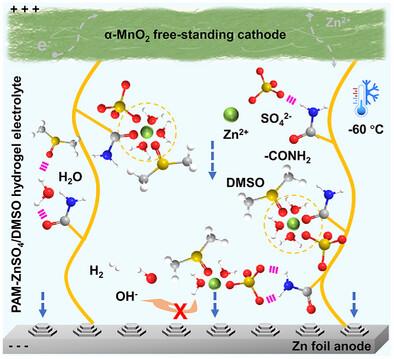Multifunctional Hydrogel Electrolyte Synergizing with Free-Standing Cathode Enables Robust Aqueous Zinc Metal Batteries
IF 12.1
2区 材料科学
Q1 CHEMISTRY, MULTIDISCIPLINARY
引用次数: 0
Abstract
Aqueous zinc metal batteries (AZMBs) have attracted increasing attention due to their low cost and high energy density. However, their practical applications are constrained by Zn dendritic growth, self-corrosion, and poor low-temperature adaptability. Herein, a multi-component hydrogel electrolyte is proposed to address these challenges. Specifically, dimethyl sulfoxide is added to substitute H2O in the Zn2+ solvation sheath and disrupt the intrinsic H─bond network, suppressing interfacial parasitic reactions induced by active water and achieving ultra-low freezing point (−60 °C); while the acylamino groups on polyacrylamide chains are utilized to coordinate with Zn2+ and SO42−, leading to homogeneous Zn2+ flux and reduced by-products accumulation. Benefitting from the synergistic effects, stable Zn plating/stripping with high average Coulombic efficiency of 99.5% for 1200 h at 0.5 mA cm−2 is achieved. To manifest the superiority of the hydrogel electrolyte, free-standing α-MnO2/single-walled carbon nanotube film is designed as cathode. The resulting AZMB exhibits large specific capacity, prominent rate capability (157.5 mAh g−1 at 10 C), high cyclic stability, and good low-temperature performance (68.8% capacity retention at −20 °C), which also demonstrates excellent safety under extreme conditions of hammering, cutting, burning, punching, and soaking. This work provides an inspired strategy to build robust, multi-functional, inexpensive aqueous batteries.

多功能水凝胶电解质与独立阴极协同作用,使水锌金属电池坚固耐用
锌金属水电池因其低成本、高能量密度等优点而受到越来越多的关注。然而,它们的实际应用受到Zn枝晶生长、自腐蚀和低温适应性差的限制。本文提出了一种多组分水凝胶电解质来解决这些挑战。具体来说,加入二甲亚砜取代Zn2+溶剂化鞘中的H2O,破坏本征H键网络,抑制活性水诱导的界面寄生反应,实现超低冰点(- 60℃);而聚丙烯酰胺链上的酰基则与Zn2+和SO42−配位,使Zn2+通量均匀,减少了副产物的积累。利用协同效应,在0.5 mA cm−2条件下稳定镀/剥离锌1200 h,平均库仑效率高达99.5%。为了体现水凝胶电解质的优越性,设计了独立的α-MnO2/单壁碳纳米管薄膜作为阴极。所制备的AZMB具有较大的比容量,突出的倍率性能(10℃时为157.5 mAh g - 1),高循环稳定性和良好的低温性能(- 20℃时容量保持率为68.8%),在锤击、切割、燃烧、冲孔和浸泡等极端条件下也表现出优异的安全性。这项工作为制造坚固、多功能、廉价的水电池提供了一种鼓舞人心的策略。
本文章由计算机程序翻译,如有差异,请以英文原文为准。
求助全文
约1分钟内获得全文
求助全文
来源期刊

Small
工程技术-材料科学:综合
CiteScore
17.70
自引率
3.80%
发文量
1830
审稿时长
2.1 months
期刊介绍:
Small serves as an exceptional platform for both experimental and theoretical studies in fundamental and applied interdisciplinary research at the nano- and microscale. The journal offers a compelling mix of peer-reviewed Research Articles, Reviews, Perspectives, and Comments.
With a remarkable 2022 Journal Impact Factor of 13.3 (Journal Citation Reports from Clarivate Analytics, 2023), Small remains among the top multidisciplinary journals, covering a wide range of topics at the interface of materials science, chemistry, physics, engineering, medicine, and biology.
Small's readership includes biochemists, biologists, biomedical scientists, chemists, engineers, information technologists, materials scientists, physicists, and theoreticians alike.
 求助内容:
求助内容: 应助结果提醒方式:
应助结果提醒方式:


